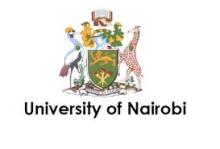Resource information
This Thesis analyzed the effects of land tenure status on land productivity and sustainable
livelihoods in the traditional pastoral areas in Narok District, and recommended policy
guidelines to the government and other stakeholders. Land tenure status is a critical concern
facing traditional pastoral areas in Kenya, especially in Narok District. It affects production
activities and influences livelihoods. Rapid population growth, deferring individual
preferences amongst the communities, the existing legal framework and inappropriate
technologies within the fragile ecosystem, pose a great challenge to sustainable livelihoods in
these areas.
The main objective of the study was to specifically analyze the effects of land tenure status
on land productivity, its influence on the intensity of land degradation and its effects on
sustainable management of land resource in terms of investment decisions on land
improvement. A survey was conducted in Narok District between October and December
2004. One hundred fifty (150) household heads were interviewed in thirty-eight (38) villages:
within five (5) Locations spread over two (2) Divisions in the medium and marginal areas in
the District. The selection of the survey villages was accomplished through a stratified
random sampling. The concept of group ranches was used as basis for the study and adopted
three models; Cobb-Douglas production function for land productivity, Tobit model for
intensity of land degradation and Multinomial Logit model for investment decisions on land
improvement. The models were estimated and the parameter estimates were interpreted.
The major findings of the study revealed that the effects of land tenure change from the
group ranch system decreased household size, increased formal education levels. decreased
reliance on livestock keeping as the sole source of livelihood. increased infrastructural and
residential status development from traditional hut to modem buildings, decreased factor
inputs productivity, increase access to credit. decrease household vulnerability to drought,
increased the number of alternative livelihood activities, increased investment decisions on
land improvement, increased technological transformation from simple tools to modem
machinery and increased intensity and accelerate land degradation. Therefore. the study
concluded that land tenure status affects land productivity and influenced livelihood
activities, and moreover, subdivision of the group ranches into individually owned parcels in
The study recommend the government to review the existing legal framework and formulate
ASALs policy with clear guidelines on land subdivision which is based on resource potential
that recognizes indigenous tenure systems and entrench gender concerns in land distribution.
The government and other stakeholders should invest in formal education efforts,
environmental conservation, and value adding processes backed up with appropriate
technology in line with alternative livelihood strategies such as dairy goats, bee keeping,
poultry and tourism related micro enterprises among others. The government through.
microfinance agencies should provide infrastructural development loans to establish
individual water sources and fodder development for each privately owned parcel. The
development plan should focus on community capacity building and strengthening household
vulnerability initiatives through effective institutional drought management measures. The
plan should seek to provide market outlet both locally and internationally that takes in large
number of livestock especially times of stress such as drought. These recommendations are
geared to guarantee sustainable livelihoods for inhabitants of the area


